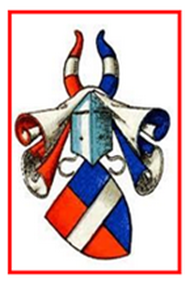
LOCHNER OF PALITZ in Bohemia
~1400 – ~1700
This Lochner line is already somewhat known to Mr. Janz, who has been the first archivist in the 1960s of the Barons Lochner of Huettenbach – but only to a few people, because the documents in archives of the Protestant nobles in Habsburg’s Bohemia were largely destroyed. The fate that befalls this branch in the course of time has also been hidden in the darkness of history, and in particular the Czech name of their related family, the Ratiborsky of Sechzebus, has posed a mystery….
The Lochner of Palitz (a village in the urban district of Eger, Bohemia – today’s name is Cheb in Czech Republic) is clearly of the same origin as Lochner of Huettenbach, i.e. they descend from the Lochners who own property in the immediate vicinity of Loch, in the village of Drossenfeld near Kulmbach, which in turn belongs to the catchment area of the Plassenburg, the center of power of the House of Hohenzollern (origin of the Prussian Kings) in Northern Upper Franconia, the nucleus of the later Margravedom of Bayreuth. The medieval road to Eger goes through the center of Drossenfeld[1].
And this is exactly where the presumed ancestor of this line, Herman II Lochner, from the Lochner of Drossenfeld line (after 1500 = Lochner of Palitz), is castleman on the Plassenburg[2] in 1399.
His sons were probably Eberhard Lochner, who moves to Nuremberg around 1400 – the Lochner of Nuremberg[3] – and Albrecht Lochner. He prefers the manor in Drossenfeld, because both brothers start the selling by the piece from 1412 on[4].
They no longer see future there, because Nuremberg offers a variety of opportunities to earn a living, and Albrecht could have married Martha, the heir-daughter of a Modschiedler branch, and therefore decides to change residence to Weismain and Arnstein (district of Lichtenfels). There she certainly has brought fiefdom into the marriage (see also: 02 HISTORY Modschiedler – in progress).
Both Albrecht and his son Herman III Lochner, also have benefited from a share of the Ebermannstadt Lochners inheritance from 1438, which sustainably documents the close relationship of the individual lines around this time. Perhaps this will influence Hermann III’s decision to remain settled in his old homeland again, because he lives in Weiher and Hollfeld in 1445, acquires property in Alladorf around 1450 and is enfeoffed with it by Margrave John of Brandenburg on the Plassenburg. A mortgage note can be found in the Eger City Archives, which indicates that he has connections to Eger about 1445[5].
In the next generation Conrad VI and George II Lochner living in Weiher near Hollfeld in 1472, a pair of brothers who have received Alladorf from the above mentioned feudal lord as early as 1467[6]. They must have been very young when their father, Herman III Lochner, dies because their grandfather Albrecht takes over the guardianship of his grandchildren in 1453[7]. The following information can already be found in the document when it has been enfeoffed “…Jorgen Lochner, his brother, who is not with the land, is to present (the fiefdom) in good faith and (…) so Jorg, his brother, is coming home, he himself should also receive this fief and do his fiefdom’s duty as is appropriate”.
Around 1477, George II Lochner of Drossenfeld makes the final decision to leave his Franconian homeland in order to build a new life for himself in Bohemia, as many aspiring lower nobility families from Franconia, Saxony, Vogtland and Austria do. At this point in time, the repurchase of the goods in Alladorf is also recorded (fief of the Margrave of Bayreuth – fief lapel from October 1st, 1477) by John of Koenigsfeld – guarantor and sealer for it is Henry V Lochner of Waischenfeld![8]
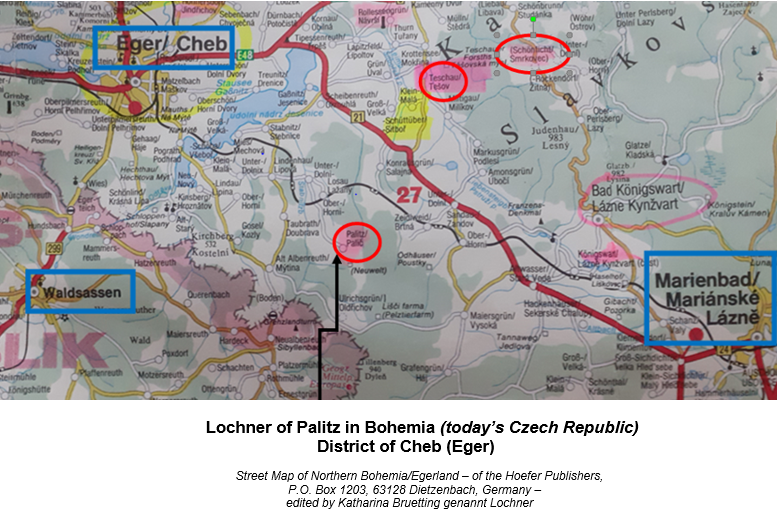

This is exactly what can be seen from the list of the ancestors in the funeral sermon[9] of his Lutheran great-great-granddaughter Elisabeth Lochner of Palitz (July 25, 1588 – March 19, 1658), which begins with her forefather named George Lochner, who has emigrated from Weiher near Hollfeld to Bohemia after 1475, where he is able to win a wife from the rich knightly family called “von der Planitz”, who own extensive estates in Vogtland.
The next generation includes his son Frederick II Lochner, who will still maintain relations with Franconia and acquires the Palitz manor near the Imperial City of Eger (Cheb) in 1498, as well as Schoenficht (Smrkovec) in the so-called “Kaiserwald” (German: Emperor’s forest – CZ: Slavkovský les), not far away, in 1509. With his wife Margret he has two sons and a daughter. As already reported, there are a lot of documents about him, for example in 1512 and 1513 he was Captain of the Waldsassen Monastery[10], where he expresses himself as “Lochner of Loch”, but then in 1514, as a steward at Waldershof near Tirschenreuth in Upper Palatinate, he now appears in the documents as LOCHNER OF PALITZ[11] for the first time (there are also numerous documents from his grandson Caspar Bernard in the Eger City Archives: he must have been a “real squabbler” par excellence and one can find another 23 fascicles about the Lochners [12]).
While the Lochner of Palitz will soon establish themselves in the Elbogen area upon River Elbe (Loket) in the district of Carlsbad (Karlovy Vary), where an imposing castle is crowning the city, they acquire the Inkolat[13] in 1615 as belonging to the Bohemian nobility. The Thirty Years‘ War brings terrible changes, because – like most of the Bohemian nobles – the Lochner of Palitz are Protestants and after the Battle of the White Mountain near Prague in 1620, from which the Catholic League and thus the Habsburgs have emerged victorious, the Palitz Lochners are confronted with the impertinent confiscation of their possessions. The Habsburgs take revenge on their enemies, the rebellious Protestants, in an extraordinarily dark medieval manner. The above-mentioned Elisabeth Lochner of Palitz will emigrate with her husband Nikolaus Wolf Ratiborsky of Sechzebus, from an old Czech noble family – so-called “Vladyks” – and 11 small children to Unterkotzau near Hof in Upper Franconia around 1630, where her husband soon departs from life[14]. Her uncle Jareslaw Hoffmann of Muenchhof as being a Protestant as well, buys the manor of Konradsreuth next to Unterkotzau, maybe as a supporter for his niece after the early dead of her husband. Other Czech noble families are recorded in her pedigree from 1588, such as the Sekerk of Sedcice or the Harant of Korschan.
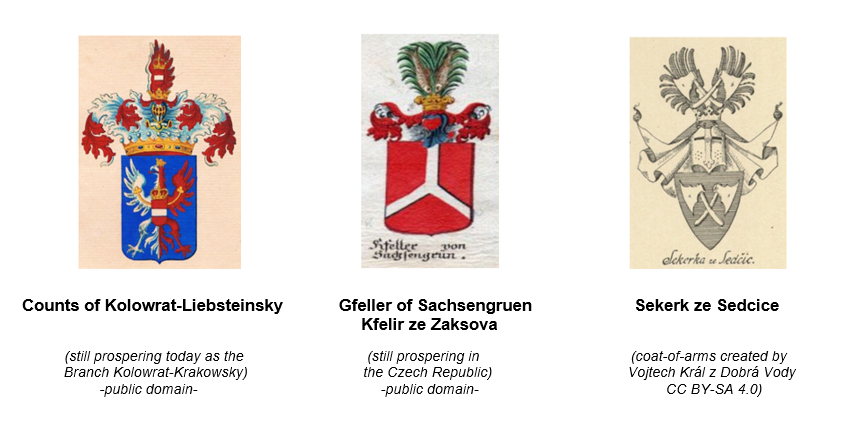
This happens after the Emperor’s re-catholicization patent of 1627, in which the Protestant Bohemian nobles are asked to either convert or emigrate. So, many of them will than leave the country for the Electorate of Saxony, whose sovereign John George I is a strictly Lutheran (see below), and he is an organizer of planning towns for the Bohemian exiles: Johanngeorgenstadt (1654), Neusalza (1670) or Ernstthal (1680)[15].

In this first wave, Elisabeth’s brother, Wolf Christoph Lochner von Palitz, must also have turned his back on Bohemia between 1620 and 1628, because his manors in Muenchhof and Imligkau are confiscated. However, in 1631 there is a brief flare-up of hope for the Protestants: the Saxons have been allies of the Swedes since 1630, who, after defeating the Catholic imperial troops in the Battle of Breitenfeld, advance deeper into the Kingdom of Bohemia under their Commander John-George of Arnim to find winter quarters. This sparked security in many Bohemian exiles that would soon turn out to be deceptive (return to their old belongings in Bohemia) – when Arnim reaches Northern Bohemia in November 1631 as to arrive in Prague on November 15th.
There Arnim, first of all, lets remove the skeletal heads of the Protestant nobles (“the ringleaders” of the Emperor) who have been cruelly murdered after the Battle of the White Mountain in 1620, known as the “Prague Blood Court” of June 21, 1621 – especially Count Joachim of Schlick (whose mother is Margaret Lochner of Liebenfels granddaughter: Anna Maria Ungnad of Weissenwolff) or, as an example, someone like the over 80-year’s-old (!) Nobleman Kaspar Kaplirz ze Sulevic (see below – his descendants currently live near Rothenburg upon Tauber in Franconia)[16].
The Czechs still consider this “Prague Bloody Court” to be the most traumatic event in their history![17]
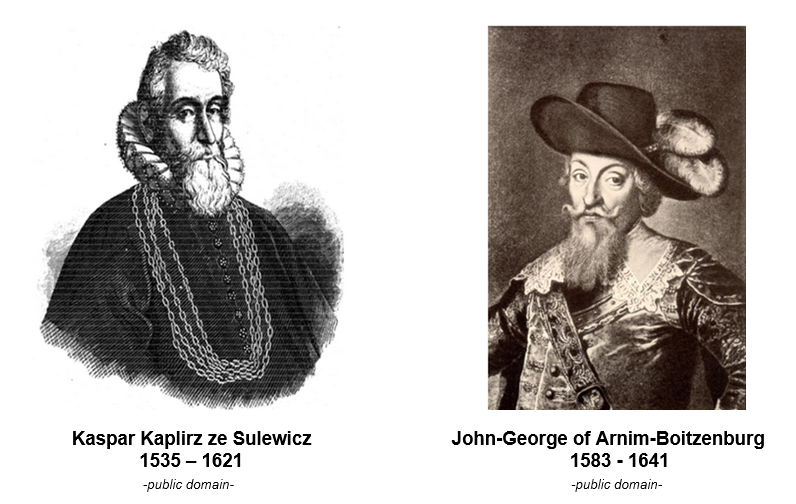
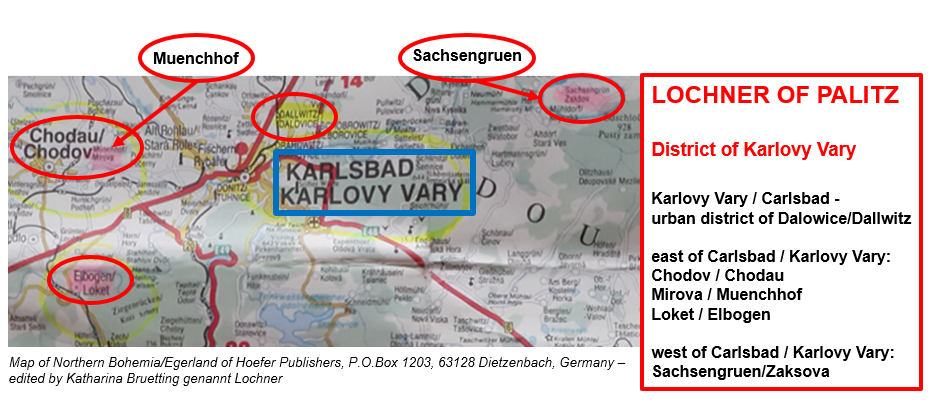
Wolf Christoph Lochner von Palitz then returns to his estates in 1631, like his distant relative Sabina Lochner of Palitz, whose husband may have fallen in the Battle of the White Mountain. Both of them have certainly been in Saxony. But this Saxon invasion remains a short episode lasting a total of 166 days, so that the Catholic troops under Wallenstein urge the Saxons out of the country again. Now the Emperor finally goes down to business seriously and sentences the Bohemian nobles, who have once again taken their property – illegally in the Imperial eyes – to significant punishments. As a result, Sabina Lochner of Palitz, née Gfeller of Sachsengruen (Kfelir ze Zaksova), like most Protestant exiles, will emigrate permanently to Saxony[18]. The rest of her family become Catholic and still live in the country today as Czech citizens – Daniel Kfelir, in his early 20’s, is a budding opera singer there.

Wolf Christoph, formerly a judge in the town of Elbogen upon the Elbe river (CZ: Loket), like his father George Florian, has to face the confiscation of all his estates in Luck (Luka) and Little-Werscheditz (Verusicky), about 30 km away from Karlsbad (Karlovy Vary), and Muenchhof (Mirova ) at Chodau (Chodov) in 1633 because he is proven to have supported the Saxons in 1631[19].
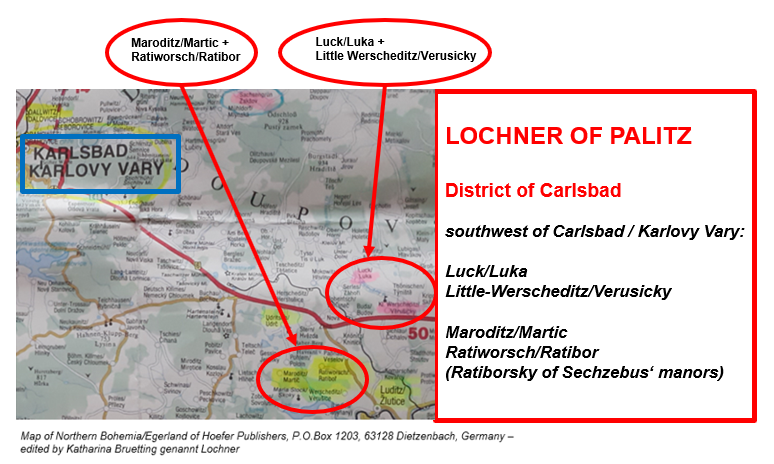
A nobleman named Alexander of Boren (Alexander Borri) is get that confiscated possession as a gift by the Emperor. However, Jakub Mirka (State District Archives in Pilsen -Plzen- in Czech Republic) states in his master’s thesis that he must have been recatholized – and so it happens that he probably „has to buy back some of his possessions” – similar to his distant cousin John Frederick II Lochner of Palitz at Dallwitz (district of Karlsbad/Karlovy Vary), who owns the village of Pauten (Poutnov) near Tepl Monastery (in the Southern district of Karlsbad/Karlovy Vary) around 1618. As a Lutheran who has supported the “Winter King” Frederick V of Palatinate (House of Wittelsbach) “may” have repurchased – after re-catholization – 2/3 of Pauten for the completely excessive sum of 1700 kopecks![20] In any case, Wolf Christoph’s son John Henry Lochner of Palitz is the owner of the two estates Luck and Little-Werscheditz until his death in 1651[21].
Wolf Christoph’s wife, Anna Catherine Proellhofer of Purkersdorf, has brought these estates into the marriage in 1615. In 1622 Wolf Christoph has already sold the eponymous manor of his ancestors in Palitz[22]. After his son John Henry Lochner of Palitz, his granddaughter Anna Barbara marries into the Bohemian nobility of the Counts of Kolowrat-Liebsteinsky, so once the branch Lochner of Liebenfels may have paved the way. In 1652, her Catholic husband Wolfgang Count of Kolowrat-Liebsteinsky takes over the Lochner estates of Luck and Little-Werscheditz[23].
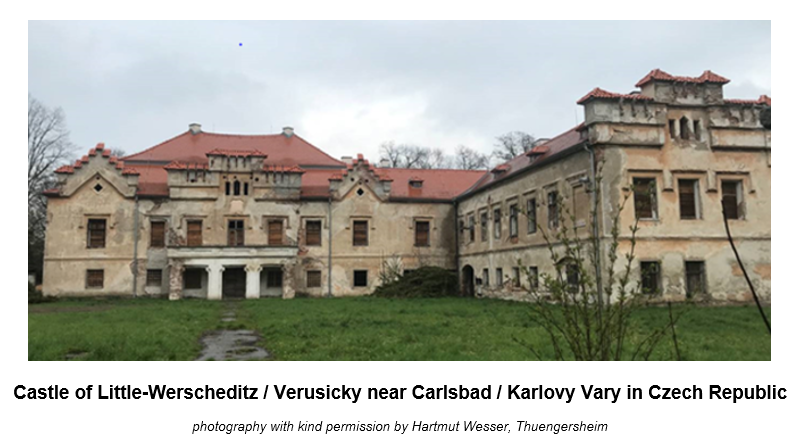
Shortly after 1700 the Palitz’ branch finally extincts
(according to the Amberg State Archives in Upper Palatinate –
see also 03 LVH HISTORY – in progress)
A n n o t a t i o n:
In fact, Prof. Dr. Vaclav Buzek from the Czech University of Budweis states in his article “The Ungnads of Sonnegg – the Lutheran nobility in the Habsburg Monarchy around the middle of the 16th century” (published in “ROCNIK” – OPERA HISTORICA, Journal of Early Modern History, No. 18 from 2017):
Andrew I Ungnad of Weissenwolff, the brother of John III Ungnad (see also: 03 HISTORY Ungnad von Weissenwolff – in progress), is granted property in the Kingdom of Bohemia, and one of his daughters of an unknown name, is married to Count Jaroslav V of Kolowrat-Liebsteinsky (Jaroslav “starsi”)* on May 25, 1555, who later on becomes Governor of Lower Lusatia in 1570.
The mother of the two Ungnad brothers is Margret Lochner of Liebenfels.
Andrew’s daughter is otherwise not mentioned in literature, because Zikuna of Guttenstein is always considered his first wife. Ungnad’s daughter probably has died in childbirth when her first child is born. The brother of Count Jaroslav V of Kolowrat-Liebsteinsky – Albrecht VI – marries Benigna Regina Welser on October 23, 1549, whose sister Philippine Welser, is in relationship with the son of Emperor Ferdinand I and his wife Anna Jagiello, namely Ferdinand II (Sovereign of Tyrol and brother of Emperor Maximilian II – see below) wedding her secretly. This represents a scandal since this wedding is below his rank (see also: 03 LVW / LVL HISTORY). The Welser Patrician family from the Imperial City of Augsburg, acting alongside the Fuggers as financiers of the Habsburgs, have been raised to the Imperial nobility in 1532 and to the baron status in 1567…
*Excerpt of the Pedigree of the Kolowrat Noble Family:
http://w.genealogy.euweb.cz/kolowrat/kolowrat2.html –

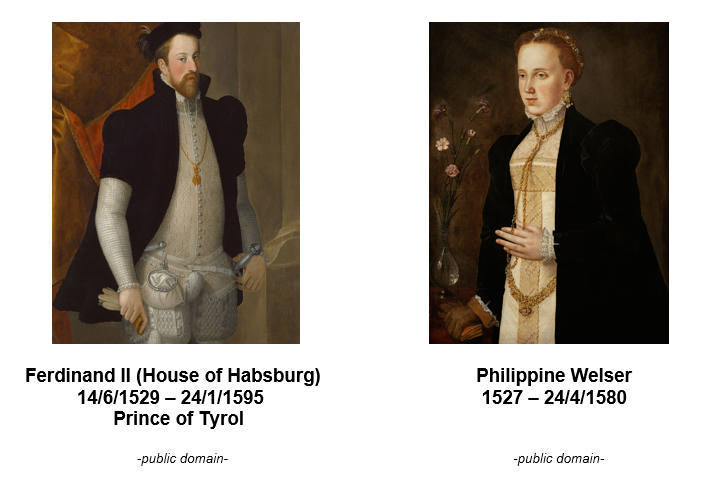
E N C L O S U R E:





FOOTNOTES:
the books mentioned are in German language but the title of the books – as footnotes – are translated for a better understanding
-
Martin Riedelbauch: „Castle and Manor of Drossenfeld“ (= today’s Neudrossenfeld, District of Kulmbach), Archives for History of Upper Franconia, vol. 53, Historical Association for Upper Franconia, Bayreuth, 1973, p. 6 ↑
-
Castle of Plassenburg at Kulmbach – Burggravial fief’s book II, 48 ↑
-
Name register for the citizens‘ books in the official and registry books of the City of Nuremberg no. 274 – 277 from 1335 – 1448, here: Eberhard Lochner 1409, registry number: 298 ↑
-
Castle of Plassenburg at Kulmbach – Burggravial fief’s book II, 50, 64 ↑
-
State Archives of the Imperial City of Eger (today’s Cheb in Czech Republic), document no. A3139 ↑
-
State Archives of Bamberg (= StA BA) A175, Lade 682, no. 1891 – lapel of January 28, 1467 (StA BA MB BT fief’s court no. 10) ↑
-
Maximilian Baron Lochner of Huettenbach – Branch Elten, inheritance, no documents proved ↑
-
StA BA A175, Lade 645, no. 422 ↑
-
Funeral sermon of Elisabeth Lochner of Palitz, married Ratiborsky of Sechzebus – according to a friendly note by Michael Haeckel (descandent of the Ratiborsky of Sechzebus) ↑
-
State Archives of Amberg, Bavaria (= StA AM), Waldsassen Monastery, document no. 1049 of 26/1/1512 ↑
-
StA AM, Waldsassen Monastery, document no 1076 of 23/ 2/1514 ↑
-
State Archives of the Imperial City of Eger (today’s Cheb in Czech Republic), document nos. A3146 – A3169 from 1573 – 1628 and document nos. A3139 – A3144 from 1445 – 1590 ↑
-
Inkolat of 1615: Bohemian nobility in the Siebmacher’s heraldic books, panel 137, p. 287 ↑
-
Exulanti.genebaze.cz – Puvod ceskych exulanti = Origin of Czech emigrants ↑
-
John Ch. Engelschall: „Description of the exile and mountain town Johanngeorgenstadt“, 1723, p. 94 ↑
-
see enclosure: literature of the Noble family Kaplirz of Sulewicz ↑
-
Dr. Oldrich Kortus: „The Saxons in Bohemia 1631 – 1632“, Prague, 2007 – in Czech language ↑
-
She sells her estates in Teschau (Tesov) and Schoenficht (Smrkovec) together with Wolf Christoph Lochner of Palitz, as guardian of her three daughters, in 1625 for 10,000 fl. to John Reinhard of Metternich, a nephew of the Elector and Bishop of Trier – Association for Numismatics: “Description of the previously known Bohemian private coins and medals” – published by the Association’s Publishing House, 1852, p. 343 ↑
-
Noble residence Muenchhof (Mirova) near Chodau (Chodov): 1633 owned by Wolf Christof Lochner of Palitz (mother: Bridget Hoffmann of Muenchhof) – Muenchhof near Chodau belonged to the Hoffmann knightly family in the 15th – 16th centuries – the Muenchhof, which was owned by the Counts of Schlick namely Caspar Schlick in 1489, is located near Schlackenwerth (Ostrov nad Ohri) – Dr. Rudolf Schreiber: “The Elbogen Land Register of the Counts of Schlick from 1525”, Prague, 1934, pp. 22, 41, 55; and Dr. Rudolf Schreiber: “The Fief’s Book of the Elbogen Captain Albrecht of Globen” (UE 40, p. 5) ↑
-
Anthony Gnirs: „Topography of historical and art historical monuments in the Tepl and Mariánské Lázně districts“, Publishers Dr. Benno Filser GmbH., Augsburg, 1932, p. 213 ↑
-
Jakub Mirka, State Archives of Pilsen, Czech Republic – Master’s thesis 2016 in Czech language: “Velkostatek Luka – Verušičky – The manors of Luck and Little-Werscheditz (17th – 19th centuries)“ ↑
-
State Archives of the Imperial City of Eger (today’s Cheb in Czech Republic), document nos. A3168 – after his uncle Caspar Bernhard Lochner of Palitz had already negotiated, he sold it to the knight Gerhard Schwoll of Falkenberg ↑
-
about Castle Luck/Luka: www.pamatkyaprirodakarlovarska.cz/luka-zamek –
about Castle Little-Werscheditz/Verusicky: www.pamatkyaprirodakarlovarska.cz/verusicky-zamek and www.hrady.cz/zamek-luka-verusicky and
on youtube.com: Castle Luka u Versuicek – Video
vary.rozhlas.cz: “After more than 70 years, the rescue of Luck Castle in the Carlsbad district starts by a man of the same name: Lubos Luka“ ↑